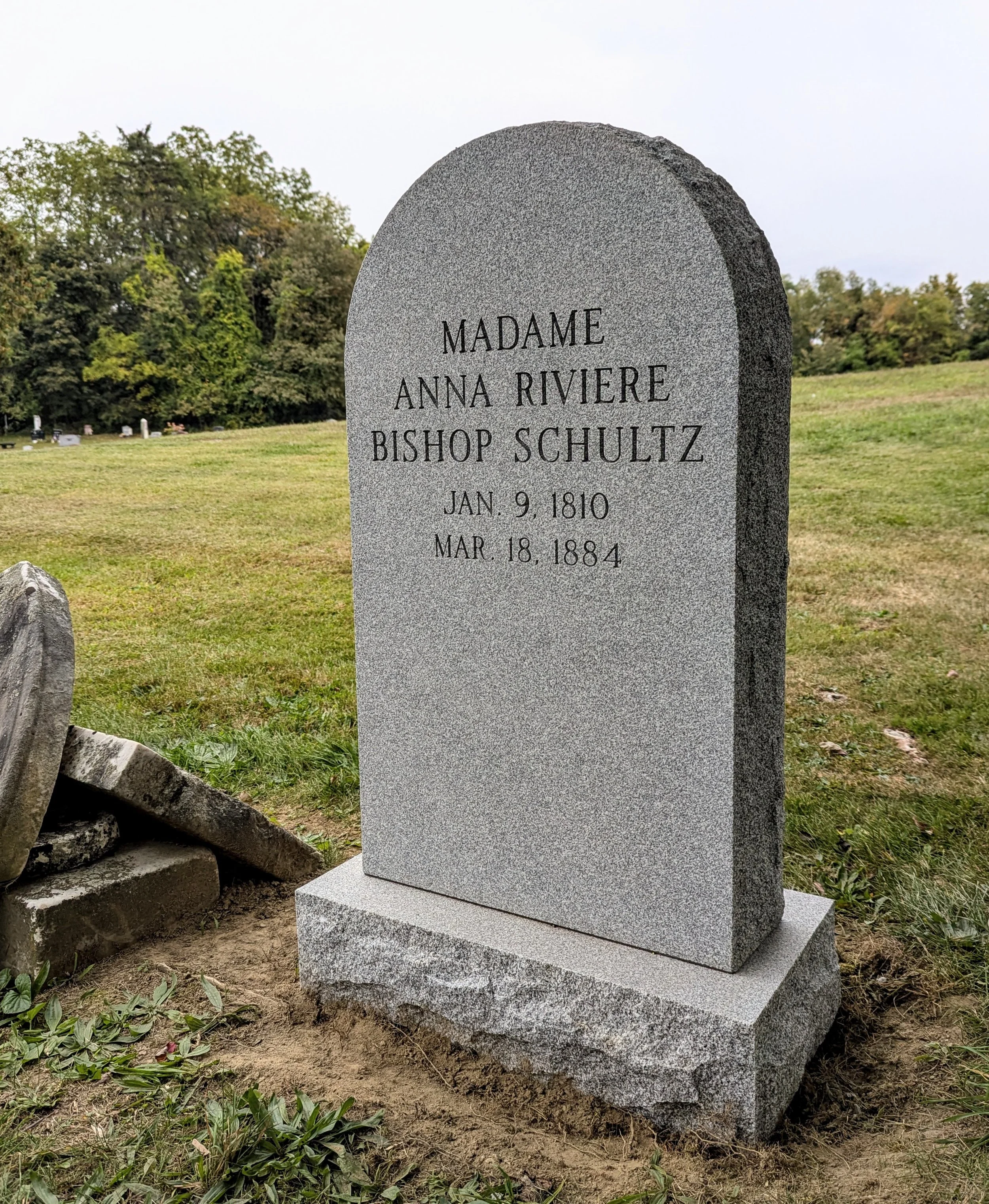HOME || CEMETERIES || SCAVENGER HUNT || MAP || MERCHANDISE
Anna Bishop
Madame Anna Bishop
Born 1810 Died 1884
St. Paul’s Lutheran Church. A simple marble post at the southern border of the old section, below the rise, near a hedge, diagonal from the pyramid.
In the 1840s and through the 1880s, “Madame” Anna Bishop was one of the most famous opera singers in the world. Born in London, Anna Riviere married her former teacher, composer Henry R. Bishop in 1831 and had three children with him, Rosa Bishop 1833–93 who married Henry Wakeford, Johanna Bishop 1837–75 who married Henry Condron, and Augustus Bishop 1837–72. In 1839 Anna left Henry for her harpist accompanist, French conductor Nicholas Boscha. She performed in Europe (including a stint as a prima donna in Naples) and toured North America in the 1840s and 50s with Boscha as her manager. She would also perform in Mexico, South America, China, Singapore, India, Australia, and South Africa. While touring Australia, Boscha died suddenly and Anna erected an elaborate memorial in a Queensland cemetery for him. A few years later, she married Martin Schultz of New York City in London. Martin’s family was from Red Hook which brought the couple to town on occasion to visit.
In 1859 a group of prominent men of Red Hook with familiar names such as Hevenor, Elseffer, Fraleigh, Massoneau, and Losee formed a committee to entice Anna to put on a performance here. Less than a month later, she sang such tunes as “Last Rose of Summer” and “John Anderson My Joe John” most likely in St. Paul’s church. She would sing all around the area in the years to follow including at St. John’s in Upper Red Hook, though it was noted she attended St. Mark’s Episcopal Church of Red Hook for services. One paper reported in 1878 she sang what was considered her signature song, “Home, Sweet Home” (written by her estranged late husband Sir Henry R. Bishop) and it was remarked “we have heard Jenny Lind and most of the renowned singers of this and foreign countries, but no one ever charmed as equal to the Madame.”
In 1866, while Anna and Martin were sailing from San Francisco to China, the barque Libelle struck the reef at Wake Island, an uninhabited atoll devoid of fresh water in the vicinity of Guam. They and other passengers and crew were stranded there for three weeks. It was decided that rescue would not come in time, so everyone loaded up on a longboat and a smaller ‘gig’. Two weeks later after storms, little food, and exposure to the elements, Anna and Martin’s longboat with 21 other survivors reached Guam. The gig was never found.
Anna’s son-in-law, steam ship Captain Condron was considered a “good fellow withal” when he visited Red Hook with Anna in 1878, staying with one of Martin’s brothers. Of her own son, Augustus Bishop, not much is known other than he was enumerated as a “goldbeater” (making gold leaf) when he lived with Martin and Anna in the 1870 census of New York City, and he may have fought in the American Civil War.
Augustus Bishop died at 34 years of age and is buried in this cemetery. Madame Anna died at her home on 4th Avenue in Manhattan quite suddenly of a stroke in 1884 at 71. Her funeral, conducted from her residence, was an Episcopal one. A reporter said that “her voice and musical taste can still give delight to the public” after she gave what was probably her final performance a month before her death.
Anna’s second husband Martin Schultz died in 1893 of typhus in New York City and it is unknown where he’s buried. Anna was buried next to her son Augustus with local Red Hook residents serving as pallbearers, but her gravesite went unmarked. In 1919 the Music Club of Annandale proposed to start a fund to mark it, but it seems nothing came of this. At some point, Augustus’ stone broke in half and became obscured, making the grave of Anna Bishop lost to visitors entirely; however, in the spring of 2022, local historian Bonnie Wood’s diligent search for this lost grave was fruitful and efforts to raise funds to give her a stone of her own were begun. On September 22nd, 2025 the new monument was placed and we can stand before Madame Anna Bishop and remember her once again.
Music in audio recording: “Home, Sweet Home” by Henry R. Bishop, 1823. Performed by Dame Joan Sutherland, Royal Opera House, Covent Garden, 1990.


